1994 CADILLAC FLEETWOOD tire type
[x] Cancel search: tire typePage 197 of 398
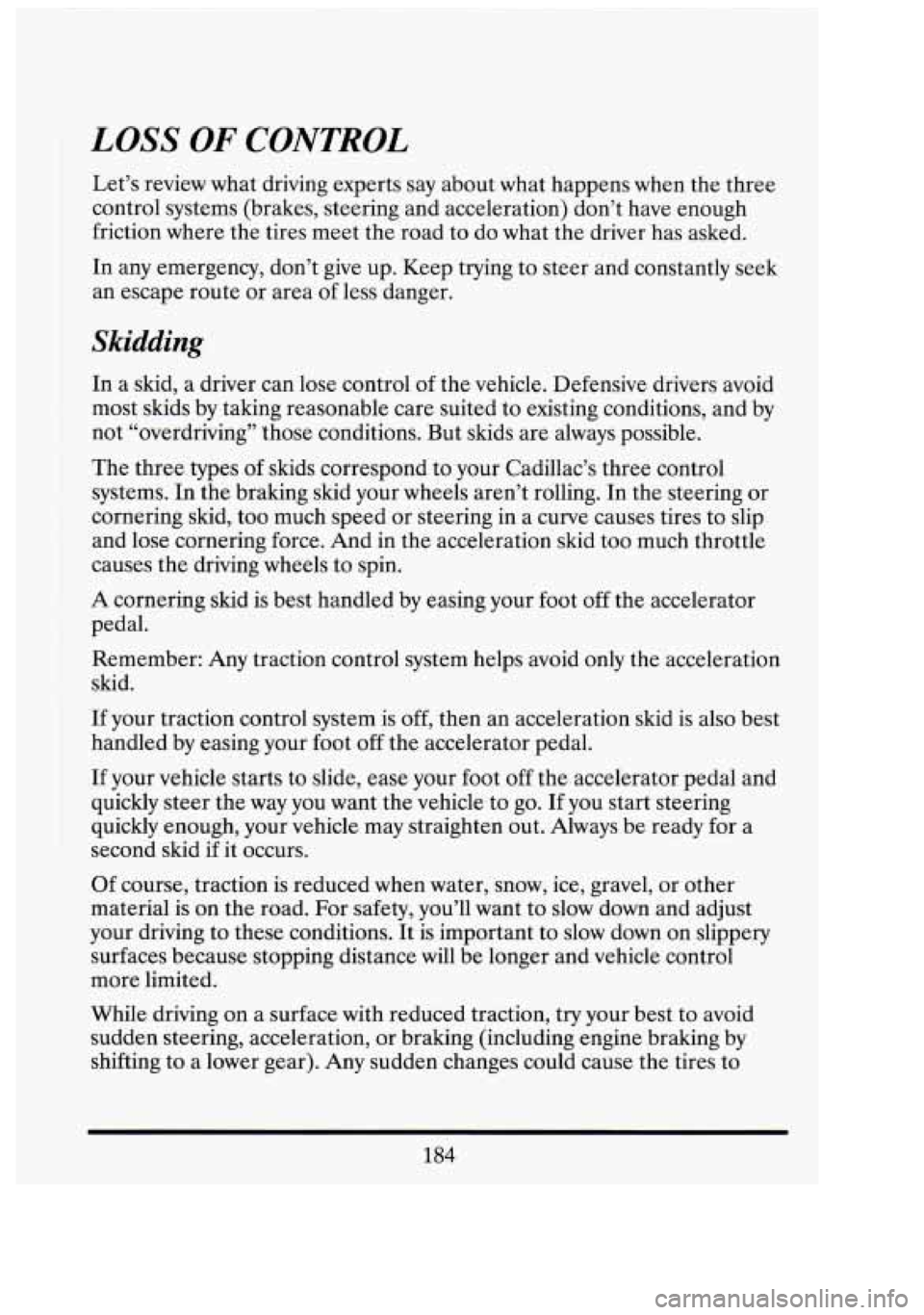
LOSS OF CONTROL
Let’s review what driving experts say about what happens when the three
control systems (brakes, steering and acceleration) don’t have enough
friction where the tires meet the road to do what the driver has asked.
In any emergency, don’t give up. Keep trying to steer and constantly seek
an escape route or area of less danger.
Skidding
In a skid, a driver can lose control of the vehicle. Defensive drivers avoid
most skids by taking reasonable care suited to existing conditions, and by
not “overdriving” those conditions. But skids are always possible.
The three types of skids correspond to your Cadillac’s three control
systems. In the braking skid your wheels aren’t rolling. In the steering
or
cornering skid, too much speed or steering in a curve causes tires to slip
and lose cornering force. And in the acceleration skid too much throttle
causes the driving wheels to spin.
A cornering
skid is best handled by easing your foot off the accelerator
pedal.
Remember: Any traction control system helps avoid only the acceleration
skid.
If your traction control system is off, then an acceleration skid is also best
handled by easing your foot off the accelerator pedal.
If your vehicle starts to slide, ease your foot
off the accelerator pedal and
quickly steer the way you want the vehicle to go. If you start steering
quickly enough, your vehicle may straighten out. Always be ready for a
second skid
if it occurs.
Of course, traction is reduced when water, snow, ice, gravel, or other
material is on the road. For safety, you’ll want to slow down and adjust
your driving to these conditions. It is important to slow down on slippery
surfaces because stopping distance will be longer and vehicle control
more limited.
While driving on a surface with reduced traction, try your best to avoid
sudden steering, acceleration, or braking (including engine braking by
shifting to a lower gear). Any sudden changes could cause the tires to
184
tl
a, i‘
c4’ I,
0 !
t
Page 306 of 398
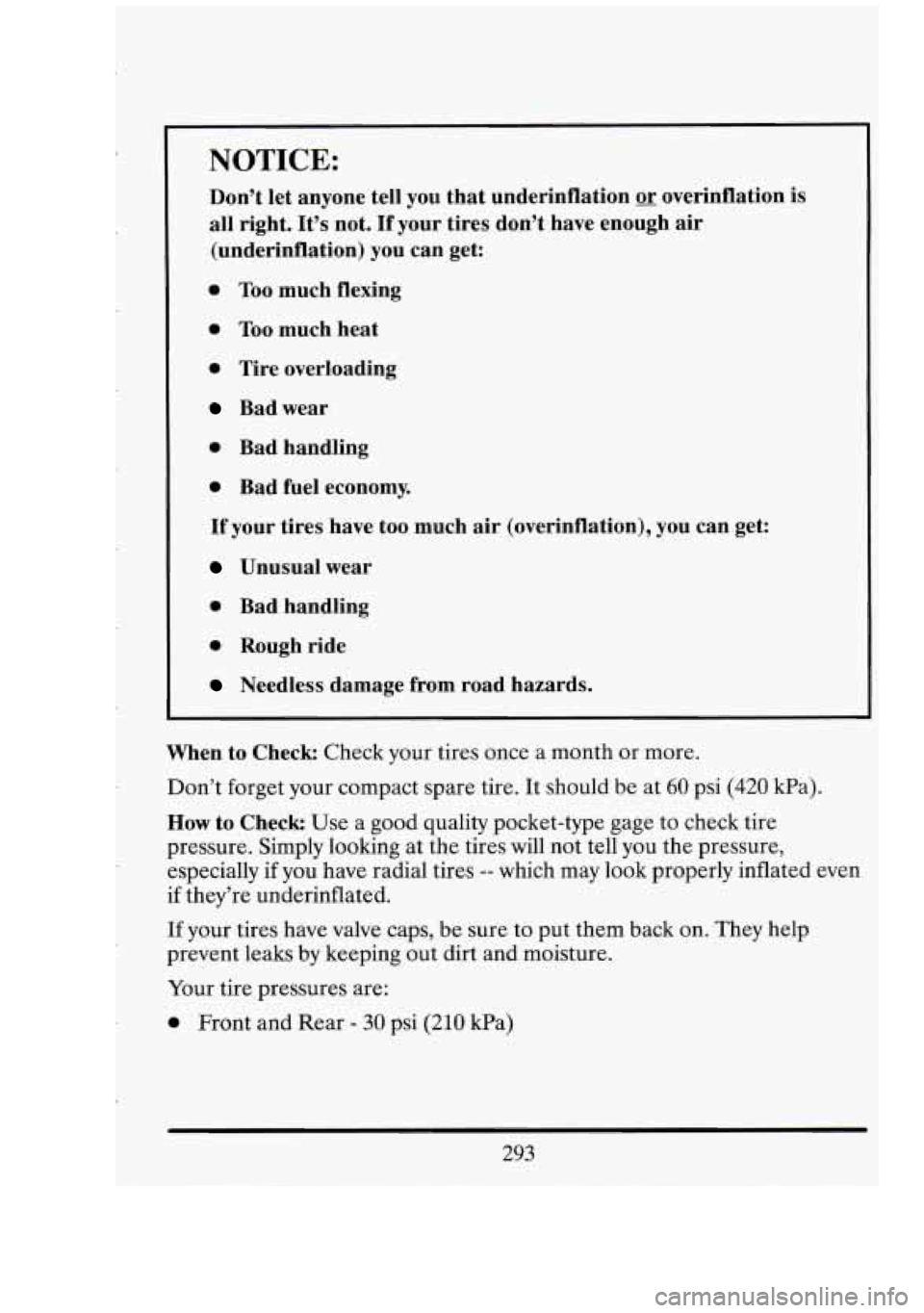
r
c-
NOTICE:
Don’t let anyone tell you that underinflation or overinflation is
all right. It’s not. If your tires don’t have enough air
(underinflation) you can get:
0 Too much flexing
0 Too much heat
0 Tire overloading
Bad wear
0 Bad handling
0 Bad fuel economy.
If your tires have too much
air (overinflation), you can get:
Unusual wear
0 Bad handling
0 Rough ride
Needless damage from road hazards.
When to Check Check your tires once a month or more.
Don’t forget your compact spare tire. It should be at
60 psi (420 kPa).
How to Check Use a good quality pocket-type gage to check tire
pressure. Simply looking at the tires will not tell
you the pressure,
especially if you have radial tires
-- which may look properly inflated even
if they’re underinflated.
If your tires have valve caps, be sure to put them back on. They help
prevent leaks by keeping out dirt and moisture.
Your tire pressures are:
0 Front and Rear - 30 psi (210 kPa)
293
Page 309 of 398
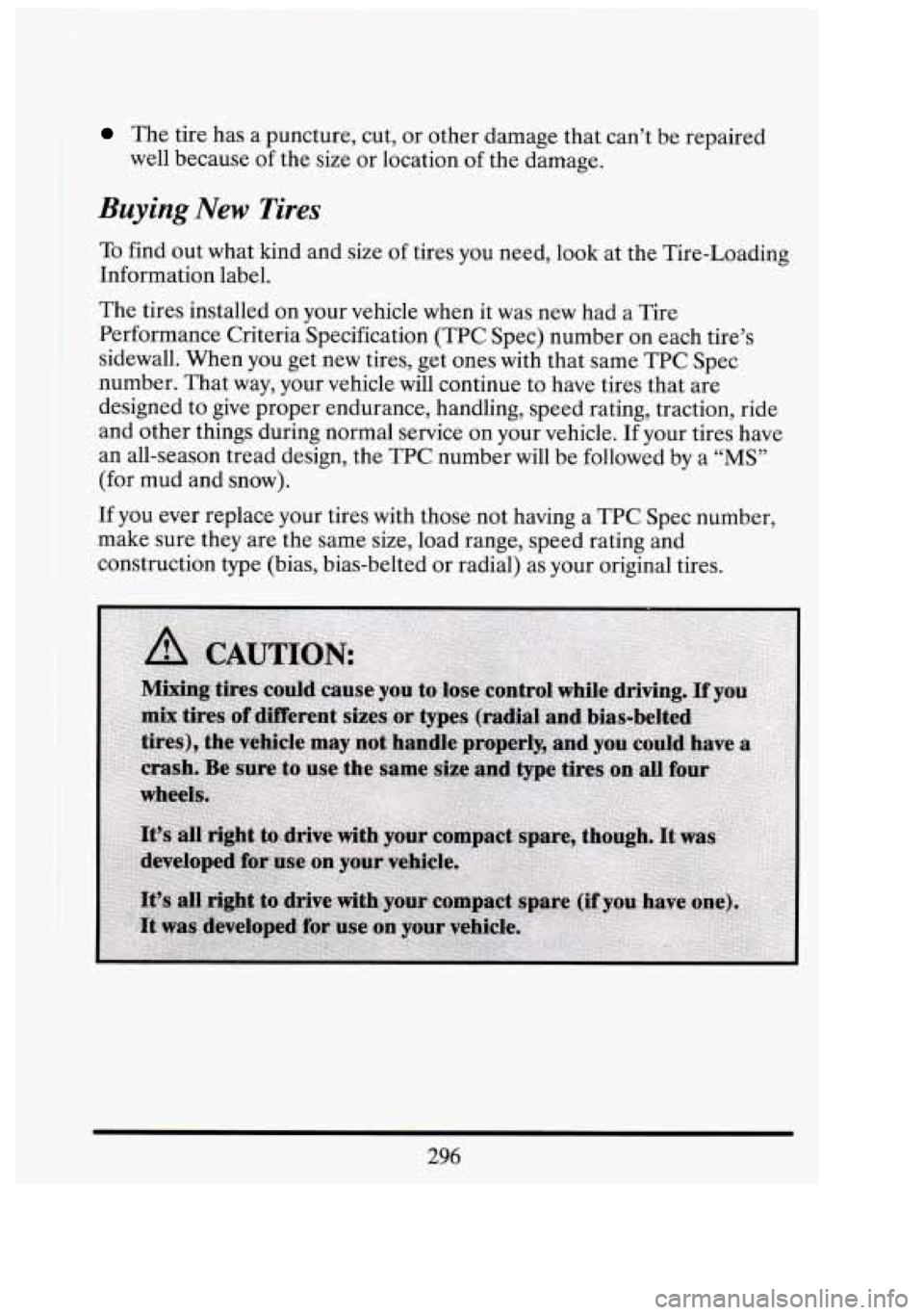
The tire has a puncture, cut, or other damage that can’t be repaired
well because of the size or location of the damage.
Buying New Tires
To find out what kind and size of tires you need, look at the Tire-Loading
Information label.
The tires installed on your vehicle
when it was new had a Tire
Performance Criteria Specification (TPC Spec) number on each tire’s
sidewall. When you get new tires, get ones with that same TPC Spec
number. That way, your vehicle will continue to have tires that are
designed to give proper endurance, handling, speed rating, traction, ride
and other things during normal service on your vehicle. If your tires have
an all-season tread design, the TPC number
will be followed by a “MS”
(for mud and snow).
If you ever replace your tires with those not having a TPC Spec number,
make sure they are the same size, load range, speed rating and
construction type (bias, bias-belted or radial) as your original tires.
ni
-1
Page 311 of 398

Warning: The temperature grade for this tire is established for a tire that
is properly inflated and not overloaded. Excessive speed, underinflation,
or excessive loading, either separately or in combination, can cause heat
These grades are molded on the sidewalls of passenger car tires.
I buildup and possible tire failure.
While the tires available as standard or optional equipment on General
Motors vehicles may vary with respect to these grades, all such tires meet
General Motors performance standards and have been approved for use
on General Motors vehicles.
All passenger type (P Metric) tires must
conform to Federal safety requirements in addition to these grades.
Wheel Alignment and Tire Balance
I
The wheels on your vehicle were aligned and balanced carefully at the
factory to give you the longest tire life and best overall performance.
In most cases, you will not need to have your wheels aligned again.
However, if you notice unusual tire wear or your vehicle pulling one way
or the other, the alignment may need to be reset. If
you notice your
vehicle vibrating when driving on a smooth road, your wheels may need
to be rebalanced.
Wheel Rephcement
Replace any wheel that is bent, cracked or badly corroded. If wheel nuts
keep coming loose, the wheel, wheel bolts, and wheel nuts should be
replaced.
If the wheel leaks air, replace it (except some aluminum wheels,
I which can sometimes be repaired). See your Cadillac dealer if any of
these conditions exist.
Your dealer will know the kind
of wheel you need.
Each new wheel should have the same load carrying capacity, diameter,
width, offset, and be mounted the same way as the one it replaces.
If you need to replace any of your wheels, wheel bolts, or wheel nuts,
replace them only with new GM original equipment parts. This way, you
will be sure to have the right wheel, wheel bolts, and wheel
nuts for your
Cadillac model.
I
ni
298
-
Page 313 of 398
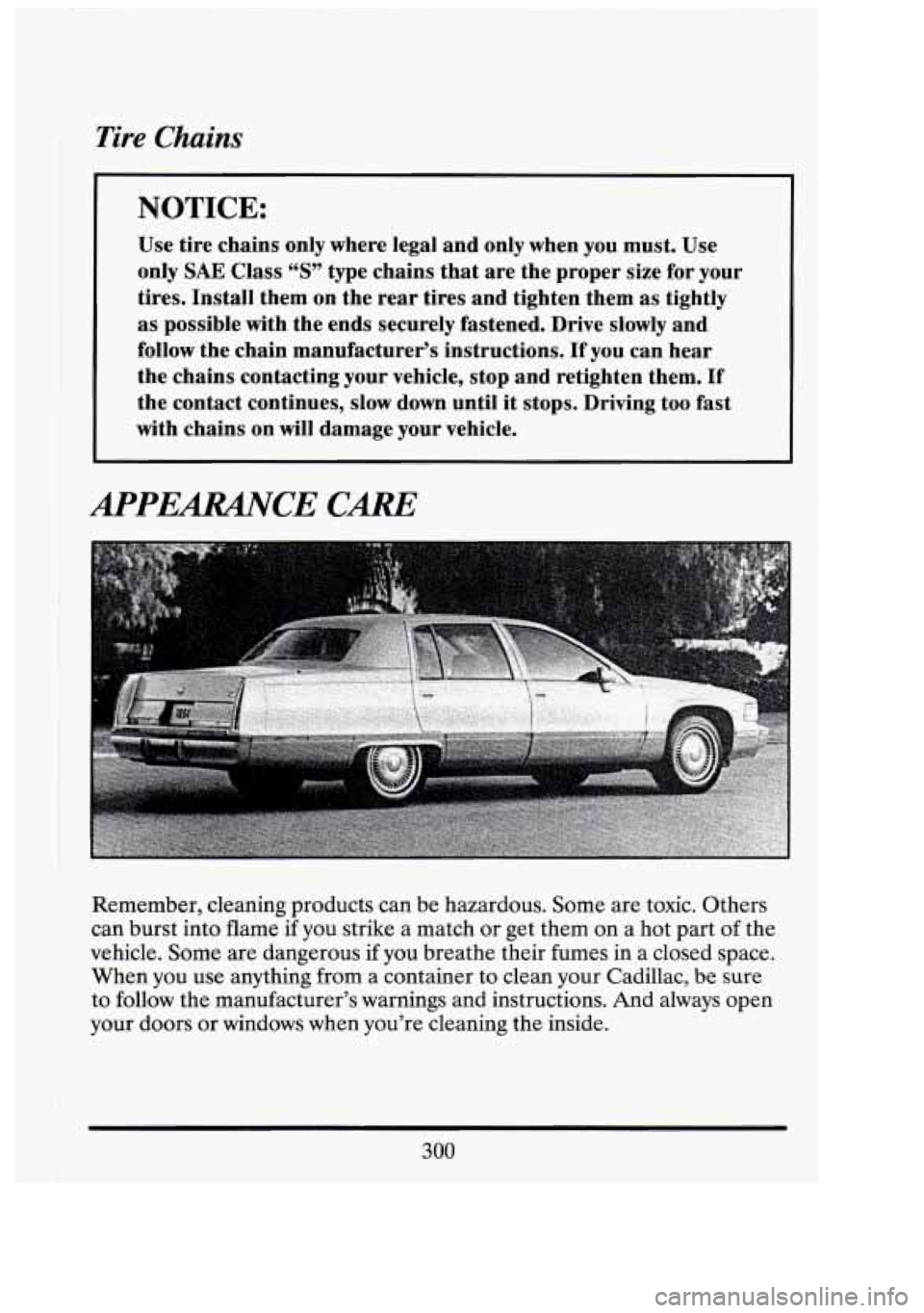
Tire Chains
NOTICE:
Use tire chains only where legal and only when you must. Use
only
SAE Class “S” type chains that are the proper size for your
tires. Install them
on the rear tires and tighten them as tightly
as possible with the ends securely fastened. Drive slowly and
follow the chain manufacturer‘s instructions.
If you can hear
the chains contacting your vehicle, stop and retighten them. If
the contact continues, slow down until it stops. Driving too fast
with chains on
will damage your vehicle.
APPEARANCE CARE
Remember, cleaning products can be hazardous. Some are toxic. Others
can burst into flame if
you strike a match or get them on a hot part of the
vehicle. Some are dangerous
if you breathe their fumes in a closed space.
When you use anything from a container
to clean your Cadillac, be sure
to follow the manufacturer’s warnings and instructions. And always open
your doors or windows when you’re cleaning the inside.
300
-1
n
1
”I
li 11.11
3
Page 315 of 398
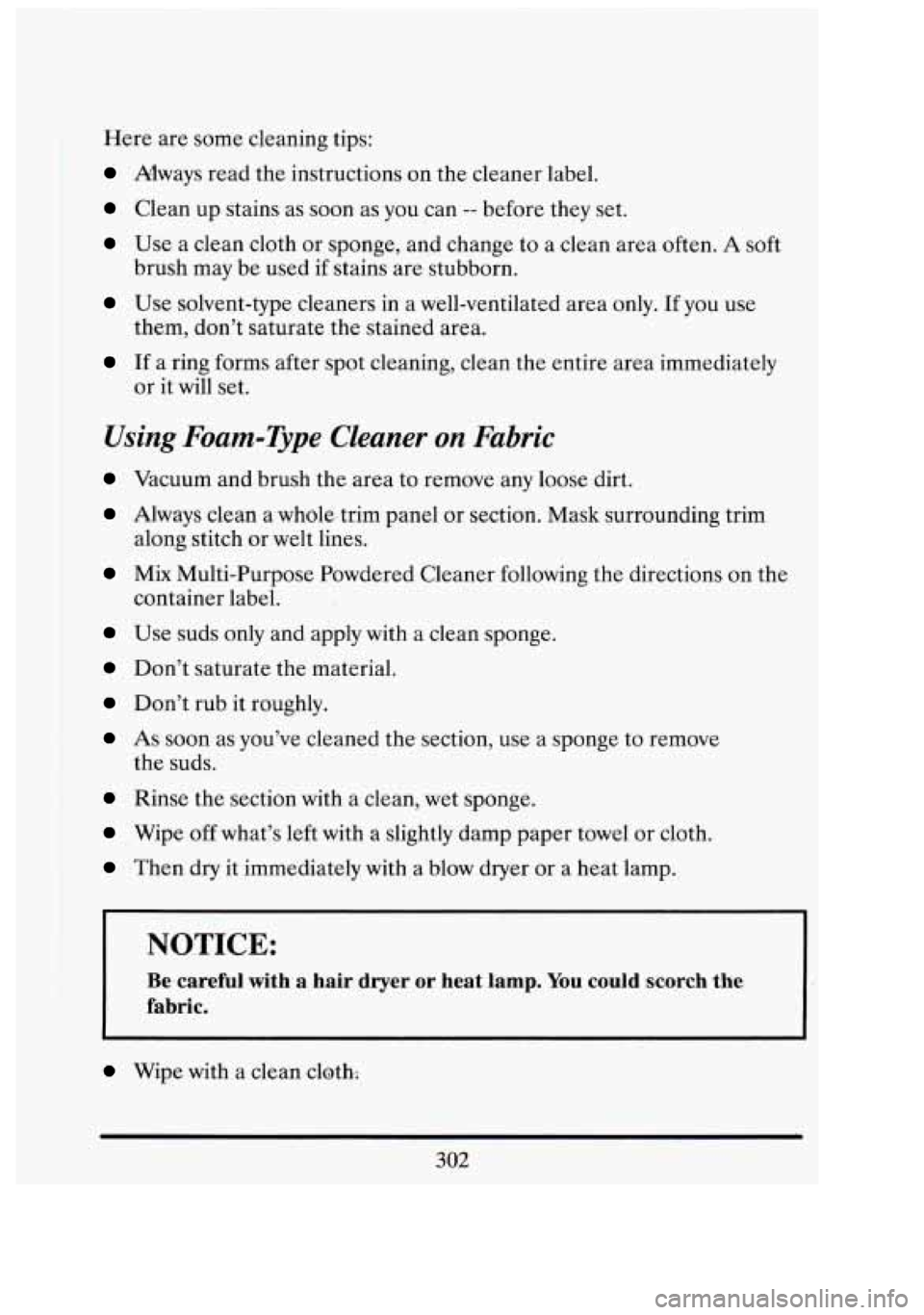
1
Here are some cleaning tips:
Always read the instructions on the cleaner label.
Clean up stains as soon as you can -- before they set.
Use a clean cloth or sponge, and change to a clean area often. A soft
Use solvent-type cleaners in a well-ventilatcd area only. If you use
brush
may be used if stains are stubborn.
them, don’t saturate .the stained area.
If a ring forms after spot cleaning, clean the entire area immediately
or it will set.
Using Foam-Type Cleaner on Fabric
Vacuum and brush the area to remove any loose dirt.
Always clean a whole,trim panel or section. Mask surrounding trim
Mix Multi-Purpose Powdered Cleaner following the directions on the
along
stitch or welt lines.
container label.
Use suds only and apply with a clean sponge.
Don’t saturate the material.
Don’t rub it roughly.
As soon as you’ve cleaned the section, use a sponge to remove
the suds.
Rinse the section with a clean, wet sponge.
Wipe off what’s left with a slightly damp paper towel or cloth.
Then dry it immediately with a blow dryer or a heat lamp.
NO.TICE:
Bexareful with.a hair dryer or heat lamp. You could scorch the
fabric.
Wipe with a clean,cloth:
nl
oi
r
c -1
& .i
302
Page 350 of 398

r
TOLL-FREE HOTLINE
1-800-882-1112
Roadside Service represents the spirit of luxury leadership at Cadillac
Motor Car Division.
We hope the need never arises, but if it does,
Roadside Service is there for you!! Roadside Service covers you
on the
road, far from home,
all day and night, weekends and holidays.
THERE ARE
NO MEMBERSHIP OR ENROLLMENT CHARGES.
Any Cadillac
is eligible under this program.
-
- ROADSIDE SERnCE AVAIUBILITY-
TYPE DAILY INCLUDING
OF ASSISTANCE
8 a.m. - 12 midnieht
Dealer Technician
24 Hours
Phone Advisor
HOLIDAYS
~ ~ ~ ~ ~ ~~~~
Towing
3attery Jump Start
Lockout Assistance
Fuel Delivery
Tire Chanee
24 hours
Cadillac Roadside Service is
just one of your Cadillac Owner
PrivilegesSm that leads to peace of mind.
1
Page 385 of 398

Exterior Appearance ................................ 300
Explanation of Maintenance Service ........ See Maint. Book
F
Fabric, Foam-we Cleaner On ....................... 302
Fabric, Solvent-Type Cleaner On ...................... 303
Fanspeeds ........................................ 148
Fasteners, Replacement ............................. 246
Features And Controls ............................... 67
Fetus, Risk To .. From Safety Belt Use .................. 38
Filling Your Fuel Tank .............................. 251
Filter, Oil ......................................... 318
Finish Care ........................................ 306
Finish Damage ..................................... 308
First Gear, When To Use ............................. 93
Flashers, Hazard Warning ........................... 213
Flat Tire .......................................... 231
Flat Tire, Changing A ............................... 232
Flooded Engine, Starting A ........................... 87
Floor Mats ........................................ 129
Fluids & Lubricants, Recommended ........ See Maint. Book
Fluid Capacities
.................................... 322
Fluid, Brake ....................................... 273
Fluid, Power Steering ............................... 270
Fluid, Transmission ................................. 262
FM Stereo Radio Reception ......................... 152
Foam-%e Cleaner On Fabric ........................ 302
Fog: Getting It Off the Windshield .................... 149
Foreign 0 eration .................................. 248
Freedom Battery, Delco ............................. 276
Freeing Car From Sand, Mud, Ice or Snow ............. 244
Freeway Driving ................................... 191
French Language Manual ............... See “Introduction”
Front Seatbacks, Reclining, Power
...................... 9
Front Towing Hook-Ups ............................. 221
Fuel .............................................. 246
FuelDoor,Locking ................................. 251
FuelEconomy ..................................... 248
FuelGage ......................................... 144
Fuel Tank, Filling Your .............................. 251
Fuse Replacement .................................. 3 12
Francais, 8 uide En .................... See “Introduction”
Front Brakes: Brake Wear Indicators
.................. 177
Fuses And Circuit Breakers .......................... 312
6
II
r,
r_
UI
r
i